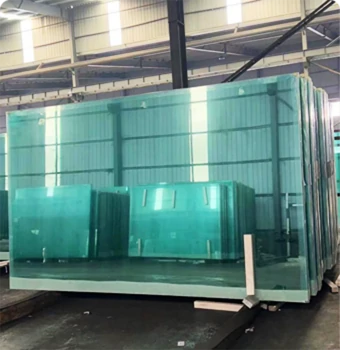Understanding the Market Dynamics of 8mm Float Glass Prices
Float glass, a type of glass widely used in the construction and automotive industries, has seen varying prices due to multiple factors over the years. Among the various thicknesses of float glass, the 8mm variant stands out as a popular choice for both residential and commercial applications. Understanding the factors influencing 8mm float glass prices can offer valuable insights into market trends and consumer decision-making.
What is Float Glass?
Float glass is created through a process that involves melting raw materials at high temperatures, followed by floating the molten glass on top of molten tin. This method results in a smooth, uniform surface and consistent thickness. The 8mm thickness offers a balance between durability and weight, making it suitable for applications such as windows, doors, and façade panels. It is also a preferred option for projects requiring enhanced thermal insulation and security.
Pricing Factors
The pricing of 8mm float glass is influenced by several critical factors
1. Raw Material Costs The key ingredients for producing float glass include silica sand, soda ash, and limestone. Fluctuations in the price of these raw materials directly affect the overall cost of producing float glass. Recent trends indicate that global supply chain disruptions and increased demand have contributed to rising raw material costs.
2. Energy Prices The float glass manufacturing process is energy-intensive. Therefore, changes in energy prices—especially natural gas and electricity—can have a significant impact on production costs. In recent years, the volatility of energy markets due to geopolitical tensions and shifts toward sustainable energy sources has added another layer of complexity to pricing.
3. Market Demand The demand for float glass is closely tied to the construction industry. When the economy is robust, and construction projects surge, so does the demand for float glass. Conversely, during economic downturns, demand can wane, leading to price reductions. The COVID-19 pandemic had initially resulted in a slowdown, but with the recovery of the construction sector, demand for 8mm float glass has begun to rebound.
8mm float glass price
4. Transportation Costs Given that glass is heavy and fragile, transportation costs play a significant role in its pricing. Fuel prices, logistics efficiency, and global trade policies can cause fluctuations in transportation expenses, further influencing the final cost of 8mm float glass.
5. Regulatory Changes Environmental regulations are becoming increasingly stringent, particularly concerning energy consumption and emissions in manufacturing processes. Compliance with these regulations may necessitate investment in new technologies, which can be passed on as higher prices for float glass.
Current Market Trends
As of late 2023, the market for 8mm float glass is witnessing a mixed trend. Prices have generally seen an upward trajectory due to the increased costs of raw materials and energy. However, advancements in production technologies aim to reduce costs over time. There is also a significant push towards sustainability, with manufacturers exploring eco-friendly alternatives and recycling processes that could affect pricing dynamics in the long run.
1. Innovation in Production Some glass manufacturers are investing in advanced technologies that improve efficiency and reduce waste. Such innovations not only help in curbing production costs but also align with global sustainability goals, potentially keeping prices stable in the future.
2. Regional Variations The price variations for 8mm float glass can differ widely from one region to another. Local demand, raw material availability, and transportation costs play crucial roles. For instance, regions with thriving construction markets may see higher prices due to increased competition for materials.
3. Global Trade Tariffs, trade agreements, and international relations influence the price of 8mm float glass. In particular, countries that heavily rely on imported glass may experience price surges if international relations deteriorate or if tariffs increase.
Conclusion
In summary, the pricing of 8mm float glass is a multifaceted issue shaped by raw material costs, energy prices, market demand, transportation logistics, and regulatory considerations. As the construction industry continues to evolve, staying informed about these factors will be essential for stakeholders—from manufacturers to consumers. Understanding these dynamics can not only aid in making informed purchasing decisions but also help businesses strategize better to remain competitive in the ever-changing glass market. As advancements in technology and sustainability practices take root, the future of 8mm float glass pricing seems poised for both challenges and opportunities.
 Afrikaans
Afrikaans  Albanian
Albanian  Amharic
Amharic  Arabic
Arabic  Armenian
Armenian  Azerbaijani
Azerbaijani  Basque
Basque  Belarusian
Belarusian  Bengali
Bengali  Bosnian
Bosnian  Bulgarian
Bulgarian  Catalan
Catalan  Cebuano
Cebuano  Corsican
Corsican  Croatian
Croatian  Czech
Czech  Danish
Danish  Dutch
Dutch  English
English  Esperanto
Esperanto  Estonian
Estonian  Finnish
Finnish  French
French  Frisian
Frisian  Galician
Galician  Georgian
Georgian  German
German  Greek
Greek  Gujarati
Gujarati  Haitian Creole
Haitian Creole  hausa
hausa  hawaiian
hawaiian  Hebrew
Hebrew  Hindi
Hindi  Miao
Miao  Hungarian
Hungarian  Icelandic
Icelandic  igbo
igbo  Indonesian
Indonesian  irish
irish  Italian
Italian  Japanese
Japanese  Javanese
Javanese  Kannada
Kannada  kazakh
kazakh  Khmer
Khmer  Rwandese
Rwandese  Korean
Korean  Kurdish
Kurdish  Kyrgyz
Kyrgyz  Lao
Lao  Latin
Latin  Latvian
Latvian  Lithuanian
Lithuanian  Luxembourgish
Luxembourgish  Macedonian
Macedonian  Malgashi
Malgashi  Malay
Malay  Malayalam
Malayalam  Maltese
Maltese  Maori
Maori  Marathi
Marathi  Mongolian
Mongolian  Myanmar
Myanmar  Nepali
Nepali  Norwegian
Norwegian  Norwegian
Norwegian  Occitan
Occitan  Pashto
Pashto  Persian
Persian  Polish
Polish  Portuguese
Portuguese  Punjabi
Punjabi  Romanian
Romanian  Russian
Russian  Samoan
Samoan  Scottish Gaelic
Scottish Gaelic  Serbian
Serbian  Sesotho
Sesotho  Shona
Shona  Sindhi
Sindhi  Sinhala
Sinhala  Slovak
Slovak  Slovenian
Slovenian  Somali
Somali  Spanish
Spanish  Sundanese
Sundanese  Swahili
Swahili  Swedish
Swedish  Tagalog
Tagalog  Tajik
Tajik  Tamil
Tamil  Tatar
Tatar  Telugu
Telugu  Thai
Thai  Turkish
Turkish  Turkmen
Turkmen  Ukrainian
Ukrainian  Urdu
Urdu  Uighur
Uighur  Uzbek
Uzbek  Vietnamese
Vietnamese  Welsh
Welsh  Bantu
Bantu  Yiddish
Yiddish  Yoruba
Yoruba  Zulu
Zulu 

